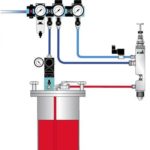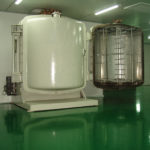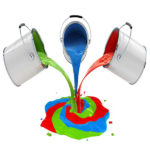Painting robot is an industrial robot that can carry out automatic painting or spraying other coatings, mainly composed by robot body, a computer and the control system, hydraulic painting robot also includes a hydraulic oil source, such as an oil pump, an oil tank and a motor. Mostly using 5 or 6 degrees of freedom structure, the arm has a large space for movement, and can do complex trajectory movements, its wrist generally has 2~3 degrees of freedom, can move flexibly. So, what are the terms for painting robots and its key parameters?
Painting robot main terms
Painting robot motion efficiency, coating efficiency and application efficiency
Motion efficiency refers to the efficiency of coating operations, including the effective utilization rate of spraying area, coating and spraying area per unit time.
Coating efficiency is the ratio of the amount of paint applied to the coated object during the spraying process to the total amount of paint actually sprayed, or the ratio of the measured thick film on the surface of the coated object to the thickness of the coating film calculated by the amount of sprayed paint, that is, the transfer efficiency of the paint (TE) or the utilization rate of the coating.
Application efficiency refers to the ratio of the surface area of the actual sprayed object to the covered area of the spray gun; In order to make the coating film of the edge break part of the coated object complete, the coverage area of the spray gun should be larger than the area of the coated object.
Painting robot spraying motion
Spraying trajectory of painting robot refers to the sequence and stroke of the spray gun running during the spraying process, and the spraying robot can imitate the spraying trajectory of skilled painters.
Painting robot paint flow rate
Paint flow rate is the amount of paint transfered to each bell per unit time, also known as the spraying flow rate and the amount (rate) of paint output.
In addition to the bell speed, the paint flow rate is the second factor that affects the fineness of the atomized particles. When other parameters remain constant, the lower the flow rate of the paint, the finer the atomized particles, but at the same time, it will also lead to an increase in the volatilization of solvents in the paint mist.
When the paint flow rate is too high and the bell is overloaded, the coating film on the bell edge will increase, resulting in the groove pattern on the bell can not make the paint divert, and the layered patent leather appears, which will produce bubbles or uneven size of paint droplets.
The maximum paint flow rate of each spray gun of the spraying robot is related to the caliber of the high-speed bell and the density of the paint at the speed, and its upper limit is determined by the fineness of atomization and the effect of electrostatic coating.Practical experience has shown that the coating should be fed at a constant speed, and fluctuations in a small range will not affect the coating film quality.
In actual spraying process, robot sprays different areas for each bell, and the paint flow rate is also different, the bell flow rate also changes due to the change of the shape of the coated object. Taking automobile body as an example, when spraying a large area such as door panels, the amount of paint atomizing should be large, when spraying door columns and window columns, the amount of paint out should be small, and this process should be automatically and accurately controlled so as to ensure the uniformity of coating quality and coating film thickness, which is also one of the important measures to improve the utilization rate of coating.
Painting robot turbo bell speed
The rotation speed of turbo bell has the greatest impact on the atomization fineness of the rotating bell at high speed.When other process parameters remain constant, the higher the speed of the bell and the smaller the diameter of the paint droplet. In the slightly lower speed range, the influence of rotational speed on atomization fineness is significantly greater than that in the high speed range.
The speed of the rotary bell will have an effect on the film thickness. When the rotation speed is too low, the coating film will be rough; If the paint atomization is too fine, it will lead to the loss of paint mist (causing overspray), which will cause the thickness of the coating film to fluctuate; When the atomization is ultra-fine, it is very sensitive to any airflow in the paint booth. In addition to overspray, excessive rotation speed of the bell can also lead to excessive wear of the turbine bearing, increase the consumption of compressed air for cleaning and reduce the solvent content of the coating film.
The optimal bell speed of the spraying robot can be determined according to the flow rate characteristics of the paint used, so the bell rotation speed for water-based coatings with high surface tension and high-viscosity two-component coatings is higher than that of ordinary solvent-based coatings. In general, the speed of the zero load bell is 6*10^4 r/min, and the speed range set under load is (1.0~4.2)*10^4 r/min, and the tolerance is ±500r/min.
The main spraying parameters of painting robot
Electrostatic spraying technology is the mainstream spraying technology in today’s automotive industry, and the application of electrostatic automatic spraying equipment has made the automotive middle coating enter the era of automation. Following is a brief description of the main spraying parameters of painting robot.
Paint flow rate
The flow rate of electrostatic painting robot is the amount of paint delivered to the bell per unit time, also known as the discharge volume. The magnitude of flow rate affects the thickness of paint film. Different colors of paint have different covering capabilities, and the thickness of the construction film is also different. During the spraying process, each robot has a different spraying area and a different flow rate. At the same time, the flow rate is also related to the shape of the sprayed object, for automobiles, the regular five-door and one-cover surface generally has a large flow rate, while the flow rate of columns, ridges, and corners is smaller.
Forming air
The air is ejected from a small hole evenly distributed on the bell back side to limit the amplitude (fan width) of the paint atomization and push the atomized paint towards the object. For metallic paints, the spray amplitude decides the final color quality, and if the spray amplitude is not suitable, it is easy to have zebra patterns or explosion. The setting of the spray width is related to the distance between two guns. For instance if the distance between the two guns is 100mm, the spray width is best controlled to 300mm.
Turbo bell speed
The bell rotation speed is the key parameter of paint atomization, and the centrifugal force generated when the bell rotates at high speed makes the paint atomized very fine (50-100μm). The smaller the droplet diameter, the better the smoothness of the paint film, the smaller the orange peel effect, and the higher the gloss.The speed setting is also related to the type of paint, the speed of the base coat is relatively small, and the speed of the middle coat and varnish is relatively high. The speed and flow are also related, if the flow rate is large, and the speed should also be increased to achieve a better atomization effect, but if the speed is too high, the paint will quick dry when sprayed on the coated object, which will lead to the problem of orange peel.
High voltage
In electrostatic spraying, the coated object is the positive electrode and the bell is the negative electrode, a strong electric attraction is generated after applying a high voltage between the two poles, so that the atomized paint particles are transmitted to the surface of the coated object. The magnitude of high voltage affects the electrostatic effect, paint application rate, and uniformity of paint film of electrostatic spraying. Flow rate, rotation speed, forming air and high pressure directly affect the quality of film formation, and also affect the paint utilization rate. In the production, it is necessary to combine the characteristics of the paint and the atomizer parameters to adjust and continuously optimized in order to achieve the ideal spraying effect.




